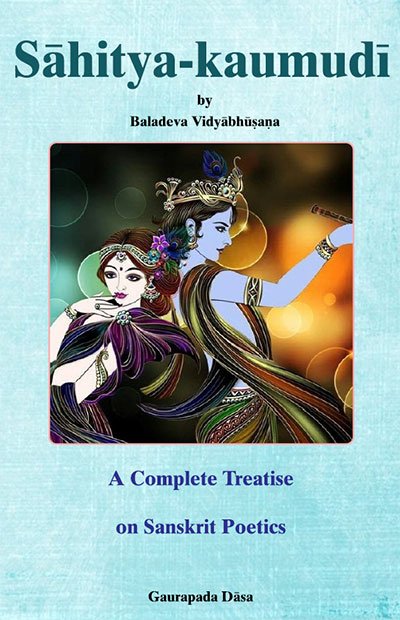Sahitya-kaumudi by Baladeva Vidyabhushana
by Gaurapada Dāsa | 2015 | 234,703 words
Baladeva Vidyabhusana’s Sahitya-kaumudi covers all aspects of poetical theory except the topic of dramaturgy. All the definitions of poetical concepts are taken from Mammata’s Kavya-prakasha, the most authoritative work on Sanskrit poetical rhetoric. Baladeva Vidyabhushana added the eleventh chapter, where he expounds additional ornaments from Visv...
Text 10.206
(3) [A quality of the effect is the opposite of a quality of the cause:]
tamāla-nīlo’pi tavaiṣa nandakaḥ
saṅgamya bhūman para-senayorjitām |
raṇājirāntaḥ śarad-indu-sundarīṃ
yaśas-tatiṃ santanute’dbhutaṃ mahat ||
tamāla—like a tamāla tree; nīlaḥ—dark (steel blue); api—although; tava—of Yours; eṣaḥ—this; nandakaḥ—Nandaka sword; saṅgamya—after meeting; bhūman—O pervader; para—of the enemies; senayā—with the army; ūrjitām—[the mass] augmented; raṇa—for battle; ajira—the place; antaḥ—within; śarat-indu—like the autumnal moon; sundarīm—beautiful; yaśaḥ—of fame; tatim—a mass; santanute—makes; adbhutam—amazement; mahat—great.
O Lord, after the battle with the enemy army, Your Nandaka sword, though dark like a tamāla tree, made Your fame excellent and beautiful like the moon. How astonishing!
atra nīla-śuklayor guṇayor virodhaḥ.
There is a contradiction between two qualities: a dark color (steel blue) (in the sword, the cause) and the white color (a symbol of fame, the effect).
